Every year, countless hours are spent preparing for Shakespeare on the Saskatchewan.
Lines are learned, sets are built, costumes are made, and then inside a big white tent beside the South Saskatchewan River in Saskatoon, the shows come to life.
Read more Saskatchewan Stories from Brittany Caffet:
- Behind the spandex: The real-life drama of Prairie Pro Wrestling
- Superstitions at play: Saskatchewan Roughriders share their gameday rituals
- Vintage quilts, modern coats: A Saskatchewan crafter’s cozy transformations
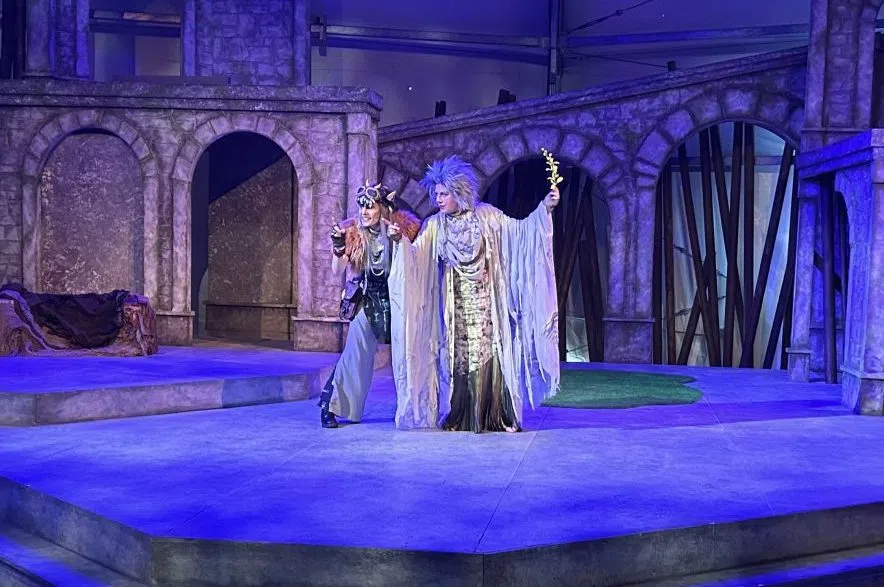
“Everyone goes, ‘Oh, Shakespeare — I didn’t like it in high school.’” Beverley Kobelsky said, shaking her head. “No, you need to see it. On its feet. Then it comes to life.” Beneath this big white tent, 400-year-old words dance again. (Brittany Caffet/650 CKOM)
But once the curtain metaphorically falls and the stage lights dim… what happens to all those costumes?
“All the costumes are in the basement,” Beverley Kobelsky said in an interview with 650 CKOM.
Listen to the story on Behind the Headlines:
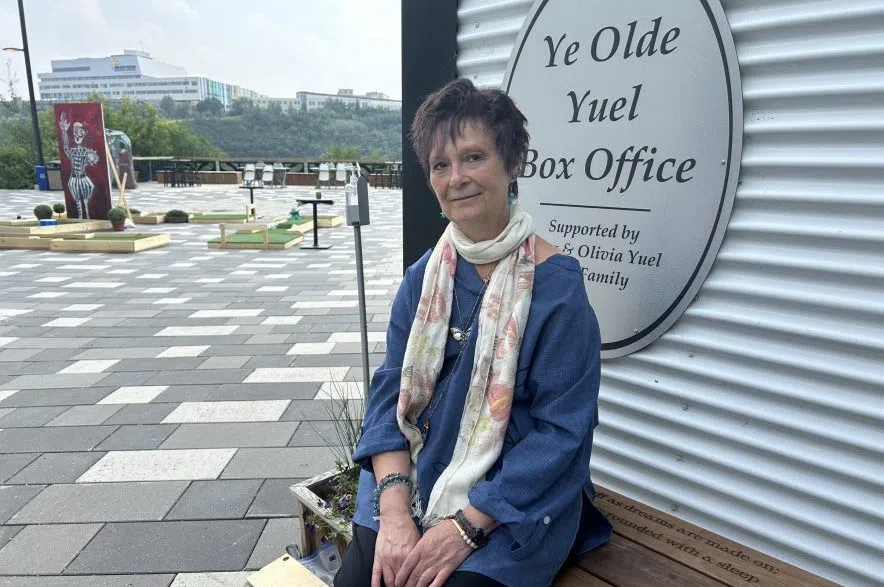
Beverley Kobelsky brings Shakespeare to life, one stitch, sequin and strange idea at a time. (Brittany Caffet/650 CKOM)
She’s been costuming Shakespeare’s kings, lovers and jesters since 1989. And this year, as the festival celebrates its 40th anniversary, she’s designing costumes for Richard II.
The basement she’s referring to lies down two steep flights of stairs, beneath the Shakespeare on the Saskatchewan office. Hidden from view, it’s a crowded, colorful labyrinth of racks and bins — a wardrobe archive spanning four decades.
And with every garment she pulls from the rack, a story emerges. Not just of a character, but of an actor, a summer, or a wild idea that somehow worked.
“I can’t remember yesterday,” she said with a laugh, fingers skimming over a rack of worn velvet sleeves, “but all this other stuff comes rushing back.”
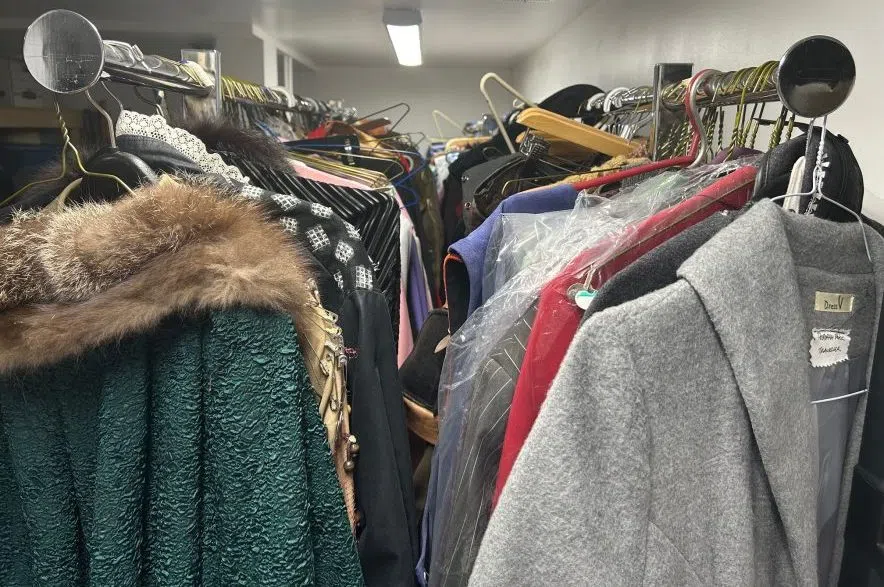
A sleeve here, a feather there — bits of monarchs, fools and lovers linger in this fabric forest. Forty summers of stories are stitched into every fold. (Brittany Caffet/650 CKOM)
A costume archive like no other
Down in the basement, the air is cooler. Fluorescent lights flicker overhead. The scent of timeworn fabric hangs in the air, and the quiet is broken only by the soft rustle of sleeves brushing against one another as you pass.
“It’s a lot of the pieces from, for sure, the last 35 years,” Kobelsky said. “So many. It’s a great place to be able to come and source and reuse.”
This is no pristine museum. The racks are packed shoulder to shoulder, sagging under the weight of velvet capes, frilled collars and wire wings. Sequins shimmer beside frayed hems, as faded tunics brush up against neon tulle and hand-painted silks. Some costumes look like they belong in a royal court, while others might’ve emerged from a fever dream.
“There’s some very unusual hand-painted, colorful pieces,” Kobelsky said, pulling back a sleeve. “You don’t find a leather tabard from Henry IV Part I in just every costume shop. That’s totally unique.”
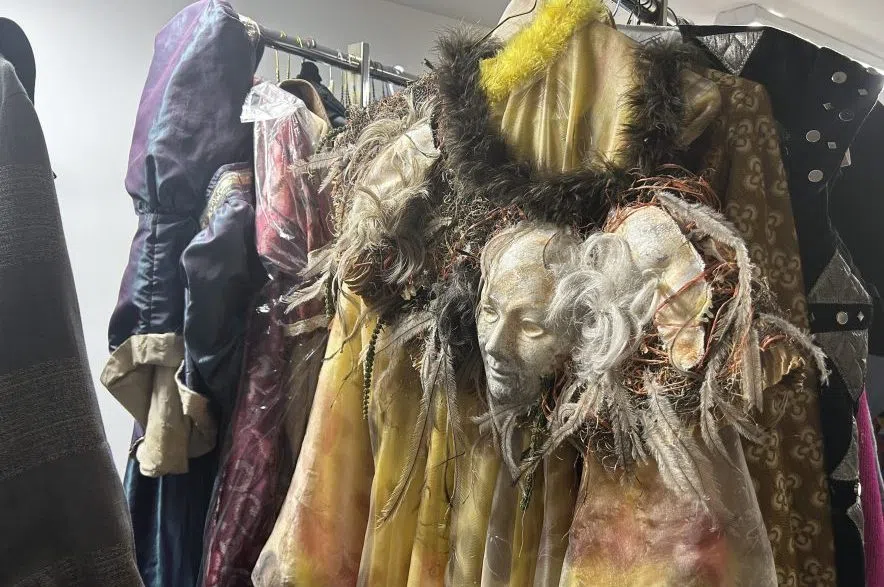
A custom design for Juliet, featuring fabric hand-painted by Kobelsky to bring softness, depth, and individuality to the character. (Brittany Caffet/650 CKOM)
The joy of building something from nothing
For Kobelsky, the creative process always begins with the script and the director’s vision.
“You read the script, usually three times, on your own,” she said. “Then you meet with the director, and hopefully at that point you have an idea of who the cast is. Generally, the director will present you with the concept.”
From there, the real magic begins — often sparked by materials that weren’t made to appear on stage at all.
“I love using materials that aren’t necessarily costume,” she said.
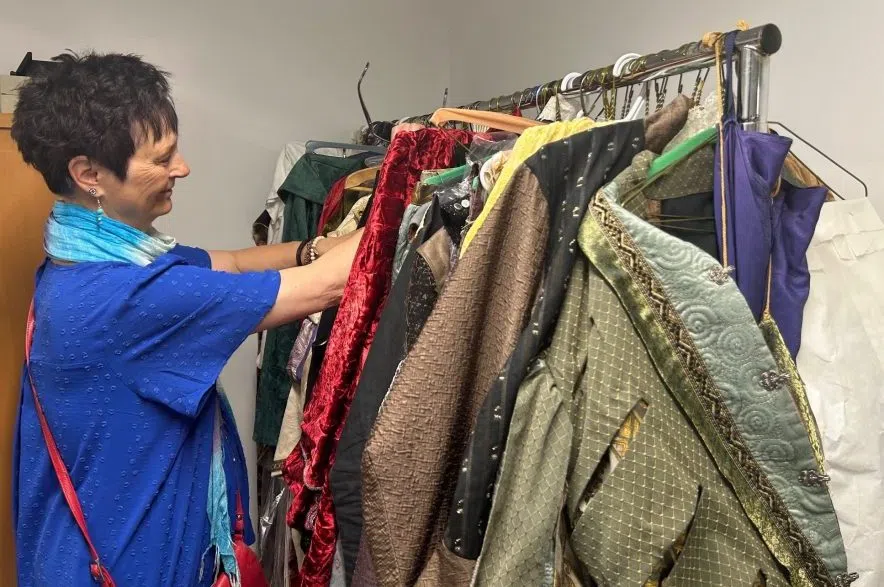
In the cool quiet of the costume vault, Kobelsky’s fingertips brush old satin and sudden memories. “I can’t remember yesterday,” she said, “but all this other stuff comes rushing back.” (Brittany Caffet/650 CKOM)
Her resourcefulness is legendary. Like the time she had to costume Richard III on a tight budget with no armor in sight.
“So we went over to the printmaking department and said, ‘Do you have any etching plates?’” she recalled. “We cut them up, filed them off, drilled holes and made this like breastplate armor, because it was free. And it made the sound of metal when running, but it’s also light, whereas steel is very heavy.”
Kobelsky also created a costume for Julius Caesar, even though Roman armor was too expensive to buy.
“I was with my head of wardrobe in Home Depot,” she said. “I looked at rubber baseboards and went, ‘Well, that’ll work.’ So we took the rubber baseboards, cut them and riveted them together — like the banded armor Romans have — and painted them to look like metal or leather.”
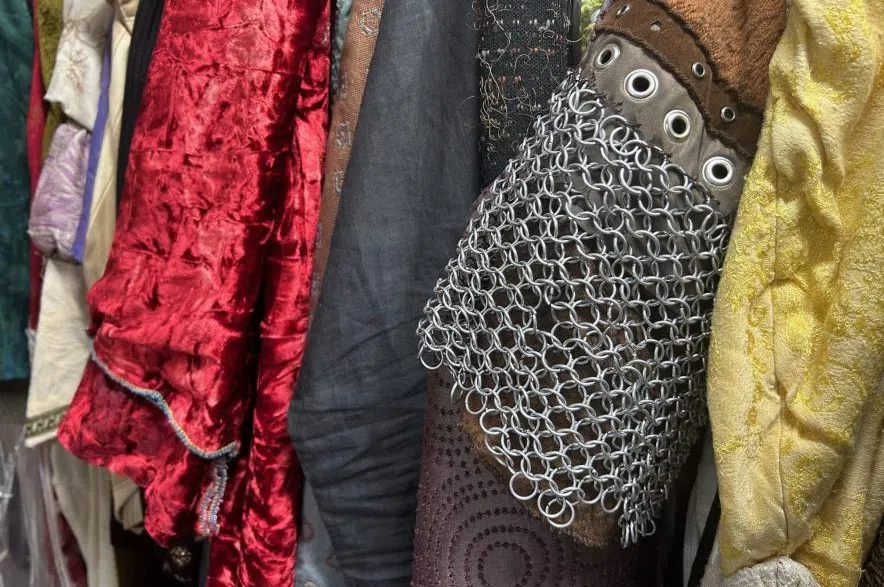
This armour never saw battle, but it shimmered under stage lights like the real thing. (Brittany Caffet/650 CKOM)
The helmets were made by a plastic company. And the plumes on top?
“I couldn’t afford horse hair or feathers, so I bought brooms and put them on top,” Kobelsky said, grinning. “The first day in costume, I came into the dressing room and the actors were on their knees pretending to sweep the floor. I said something to them that I can’t repeat. And oh, then we laughed and laughed. It was just so funny.”
One of Kobelsky’s most memorable creations was a dress designed after the budget ran out. The concept demanded something spectacular.
“The concept was apocalyptic, and I said, ‘Well, I have bubble wrap,’” she recalled with a laugh. “One of my stitchers suggested we could fill the bubbles with beads and sequins, so three of us took knives, cut open the bubbles, filled them, taped them shut and finished it. It took about eight hours.”
That dress now lives at the drama department at the University of Saskatchewan where Kobelsky teaches, inspiring students to think outside the box — or the bubble wrap.
“It’s just so much fun to play and create art,” she said.
Shakespeare, but make it weird
If you think working with 400-year-old scripts means sticking to tradition, think again.
Shakespeare on the Saskatchewan has a reputation for reimagining the Bard’s plays in fresh, unexpected ways, mixing eras, styles and concepts to make the stories resonate today.
“I love the creativity and going out on a limb with many of the concepts I’ve been able to work on,” Kobelsky said. “Very often, when you’re given a play, the structure is given. But with Shakespeare, we can play with the concepts and do different things with it.”
Take Much Ado About Nothing — where insects were the concept.
“It was my very first full-on design here,” she remembered with a smile. “From what I’ve been told, people still talk about that show. It was very memorable for me.”
Then there was the production of The Merry Wives of Windsor set in the 1930s Dust Bowl.
“It’s a comedy, but (the director) wanted it in the Dust Bowl depression of the ’30s — but colorful and cloud-like,” she said, smiling at the memory of the unusual request.
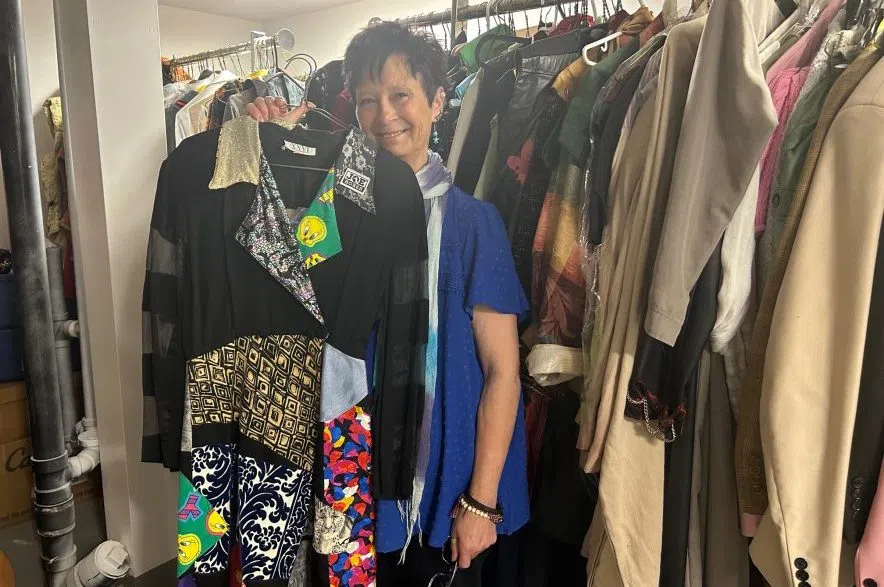
Out of scraps, something splendid. Kobelsky said this costume was born from remnants — a patchwork of past performances sewn into new life. (Brittany Caffet/650 CKOM)
“You’ll hate me in July, but love me in August”
Working outdoors in Saskatoon brings its own challenges.
“It’s better now, because we have a much different facility,” Kobelsky said. “We have the big fan, which is a huge change for the actors on stage. You have the movement of air and coolness. We have an air-conditioned trailer, which is the dressing room.”
But it hasn’t always been that way. Prior to the unveiling of the festival’s permanent amphitheatre in 2020, the performances would take place in a large tent. And that tent was hot. On especially warm days, heavy costumes had to be swapped out or stripped down to keep the actors comfortable.
“There’s an equity rule — if it hits 40 C in the tent, you have to cancel the show,” she said. “So you do try to think of those things. OK, if it’s really super hot, then lose these pieces.”
But while some performances could be sweltering, Saskatchewan’s weather has always had a way of turning quickly.
“I used to tease them,” Kobelsky recalled. “I said, ‘You’ll hate me in July but love me in August,’ because July was always hot, but August it would be very cold.”
One specific chilly night stands out in her memory.
“We were doing Hamlet, 1994. It was very cold that summer, and James O’Shea, who played Hamlet — he sweats a lot,” she laughed. “So the first preview, I leaned over to my costume assistant and said, ‘Is he steaming?’ Because his body had so much sweat, and it was so cold, steam was rising from his body.”
Steam rising off Hamlet’s body was dramatic. But the less glamorous part? Keeping his costume from smelling like dirty gym socks.
“We spot clean often,” she said. “If they’re large pieces, we use what’s called a dress shield or pit pads. You can take that off.”
Performers wear undershirts and socks that are laundered after every show. And for years, the secret weapon was vodka.
“Half vodka, half water. It kills the germs and removes the smell,” she explained. “We’ve moved more into isopropyl alcohol now.”
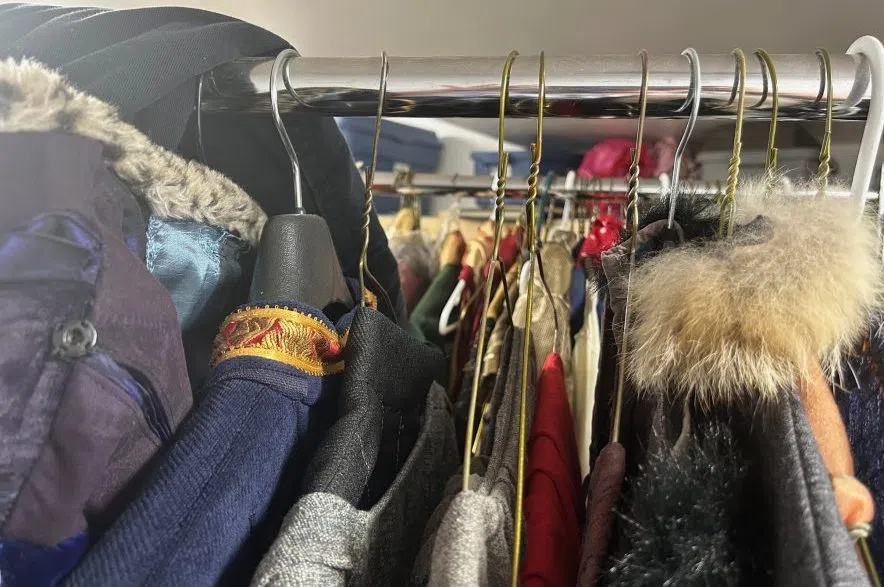
Hundreds of costumes lie in wait in this basement archive, waiting for a second act. (Brittany Caffet/650 CKOM)
Where stories live on
When the last audience member has left and the bright stage lights have dimmed, Shakespeare on the Saskatchewan doesn’t simply disappear.
Instead, it retreats quietly to a space beneath the festival office — a crowded basement filled with racks and bins, where costumes from 40 years of summers hang patiently, waiting for their next moment to shine.
Kobelsky sees this space — and the festival itself — as a reminder that Shakespeare’s work isn’t meant to be stuck in textbooks or classrooms.
“Everyone goes, ‘Oh, Shakespeare. I don’t like it, I took it in high school,’” she lamented. “No, you need to see it. It needs to be on its feet, it needs to be performed, and then it comes to life.”
As the festival celebrates its 40th anniversary, that message feels more important than ever. Because here, surrounded by costumes worn by kings, jesters and lovers across four decades, Shakespeare is more than words on a page — it’s a living, breathing experience.
In this basement, the past and future meet, waiting patiently for the next season, the next story and the next chance to bring Shakespeare back to life.
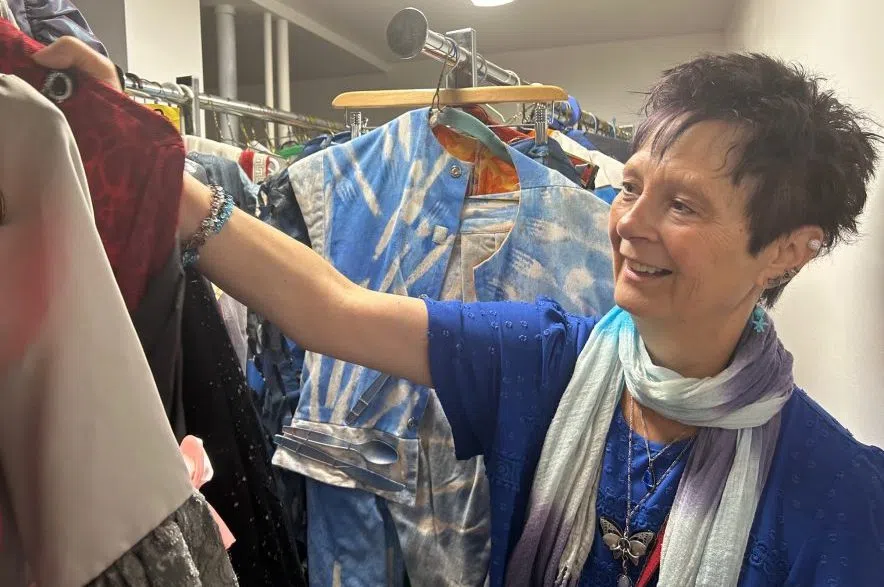
Shakespeare on the Saskatchewan has been a summer tradition for 40 years, and Beverley Kobelsky has costumed nearly all of them. The longtime designer invited 650 CKOM’s Brittany Caffet into the hidden basement archive where decades of theatre history hang shoulder to shoulder. (Brittany Caffet/650 CKOM)











